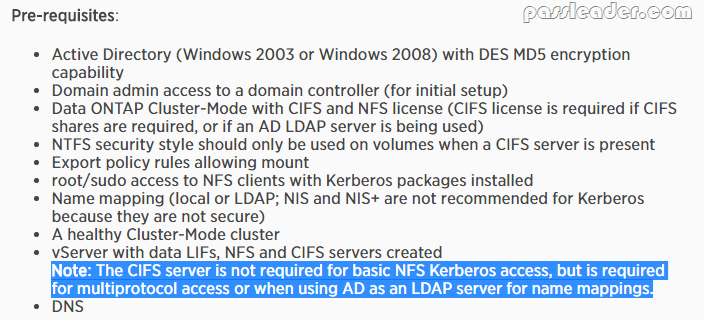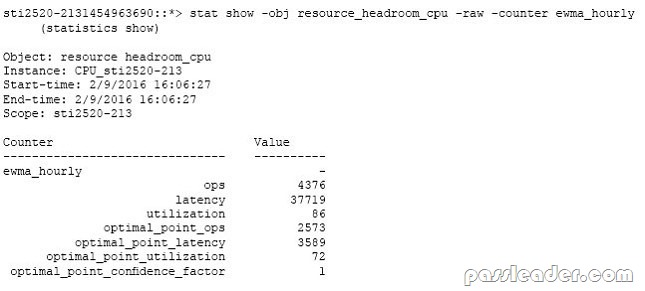New and Valid for 100% Passing Ensure NetApp NS0-158 Dumps from PassLeader: https://www.passleader.com/ns0-158.html (121 Q&As), PassLeader offer both NS0-158 VCE Dumps and NS0-158 PDF Dumps for Preparing for the NetApp NS0-158 Exam, 100% Valid and 100% Passing Guarantee.
More, you can download the latest PassLeader NS0-158 Exam Dumps Online for FREE: https://drive.google.com/open?id=0B-ob6L_QjGLpSENxalhYZENPOWs
QUESTION 37
You have a 2-node cluster named cl1 that has separate LIFs on each node for both SAN and NAS traffic. A storage failover takeover process is initiated as shown in the exhibit. In this scenario, which two statements about the takeover process are true? (Choose two.)
A. The SAN LIFs on cl1-01 go offline.
B. The NAS LIFs on cl1-01 automatically migrate to cl1-02.
C. The NAS LIFs on cl1-01 go offline.
D. The SAN LIFs on cl1-01 automatically migrate to cl1-02.
Answer: AB
QUESTION 38
You are creating the source and destination SVMs for a new SVM disaster recovery relationship. Which SVM set of subtypes should you choose?
A. Source SVM default, Destination SVM: default
B. Source SVM default, Destination SVM: dp-destination
C. Source SVM default, Destination SVM: sync-dest
D. Source SVM default, Destination SVM: sync-dest
Answer: B
Explanation:
A destination Storage Virtual Machine (SVM) is an SVM with the dp-destination subtype created for protecting a source SVM that serves data. A destination SVM contains replicated data and configuration of the source SVM.
https://library.netapp.com/ecmdocs/ECMP12454817/html/GUID-62D54AB4-BAE3-49A9-8F43-98DC03BC4602.html
QUESTION 39
You have a volume in an SVM that needs to be moved to a different SVM. You do not have room to copy the volume to the other SVM. Which ONTAP command will accomplish this task?
A. volume rehost
B. volume mount
C. volume modify
D. volume move
Answer: A
Explanation:
If you have been working with Netapp Clustered Data Ontap for a while now you would no doubt have performed quite a few volume moves. However one limitation of the volume move command was that you couldn’t move the volume between storage virtual machines (SVM’s). Starting with Ontap 9 we can now move a volume between Storage Virtual Machines (SVM’s). This is done with the volume rehost command.
http://www.sysadmintutorials.com/netapp-ontap-9-volume-rehost/
QUESTION 40
On the first LUN entry shown in the exhibit, a hyphen (-) appears under reporting-nodes. What are two reasons why the hyphen appears? (Choose two.)
A. The hyphen indicates that no nodes are reporting paths to the LUN.
B. The hyphen indicates that all nodes are reporting paths to the LUN.
C. The hyphen is the default for SLM on LUNs create in ONTAP 8.3 and later.
D. The hyphen is the default for SLM on LUNs create before ONTAP 8.3.
Answer: BC
Explanation:
https://library.netapp.com/ecm/ecm_download_file/ECMP12425790 (page 13)
QUESTION 41
Users report that they are unable to connect to home directories stored on a NetApp cluster. You are using Active Directory-based Kerberos authentication. Which two actions would correct the problem? (Choose two.)
A. Verify that the CIFS server in running in the SVM.
B. Verify that the Network Time Protocol service is in sync.
C. Verify that an Active Directory domain admin account is configured in ONTAP.
D. Verify that domain tunneling is configured in ONTAP.
Answer: AC
Explanation:
Kerberized NFS in Cluster-Mode for use with Active Directory Pre-requisites include:
https://kb.netapp.com/support/s/article/ka31A0000000uYJQAY/how-to-set-up-kerberized-nfs-in-cluster-mode-with-active-directory?language=en_US
QUESTION 42
You have a cluster of FAS controllers with HDD aggregates. The data is being compressed into 32 KB blocks before being written to a volume. In this scenario, which type of compression is being used?
A. secondary, inline compression
B. adaptive, inline compression
C. adaptive, postprocess compression
D. secondary, postprocess compression
Answer: A
Explanation:
NetApp data compression reduces the physical capacity required to store data on storage systems by compressing data within a flexible volume (FlexVol volume) on primary, secondary, and archive storage. It compresses regular files, virtual local disks, and LUNs. When NetApp data compression is configured for inline operation, data is compressed in memory before it is written to disk.
QUESTION 43
You have a 2-node NetApp cluster. You would like to use an onboard UTA2 port for host connectivity. The port was previously connected to a tape library using native FC. What must you do to configure the port for host connectivity?
A. Change the port mode to FC.
B. Change the port mode to CNA.
C. Change the FC type to initiator.
D. Change the FC type to target.
Answer: B
Explanation:
Certain converged network adapters (CNAs), such as the X1143 adapter and the UTA2 onboard ports, contain offload support for LLDP.
See: ONTAP 9. 0 Network_Management_Guide (January 2017) (page 98)
https://library.netapp.com/ecm/ecm_download_file/ECMLP2492610
QUESTION 44
You have a SnapLock Compliance volume that needs to be replicated to a different cluster at a disaster recovery site. Which two statements concerning the SnapMirror destination volume are true? (Choose two.)
A. The destination volume type must be SnapLock Enterprise.
B. The destination volume type must be SnapLock Compliance.
C. The destination cluster does not require a SnapLock license.
D. The destination cluster requires a SnapLock license.
Answer: BD
Explanation:
B: To create an end-to-end relationship between SnapLock Compliance volumes by using SnapMirror, you need to create both the source and the destination volumes as SnapLock Compliance volumes and then initialize the mirroring relationship by using the snapmirror initialize command. The other commands you use differ depending on whether you are creating a volume SnapMirror relationship for a traditional volume or a FlexVol volume.
D: A SnapLock license entitles you to use both SnapLock Compliance mode and SnapLock Enterprise mode. SnapLock licenses are issued on a per-node basis. You must install a license for each node that hosts a SnapLock aggregate.
https://library.netapp.com/ecmdocs/ECMP1196889/html/GUID-8ACE3CAB-D338-4AFC-A530-0D0FEC3B9F94.html
https://library.netapp.com/ecm/ecm_download_file/ECMLP2507748
QUESTION 45
Referring to the exhibit, which statement is true?
A. The node’s aggregates have been underutilized on average for the past one hour.
B. The node’s CPU has been underutilized on average for the past one hour.
C. The node’s CPU has been overutilized on average for the past one hour.
D. The node’s aggregates have been overutilized on average for the past one hour.
Answer: C
Explanation:
http://docs.netapp.com/ontap-9/index.jsp?topic=%2Fcom.netapp.doc.pow-perf-mon%2FGUID-50CA6406-8C7A-46C0-8251-D1605CEF0D96.html
Trying the PassLeader NS0-158 Dumps in VCE and PDF for Your First Attempt and 100% Passing: https://www.passleader.com/ns0-158.html (121 Q&As, VCE and PDF)
More, download new PassLeader NS0-158 Exam Dumps for FREE: https://drive.google.com/open?id=0B-ob6L_QjGLpSENxalhYZENPOWs